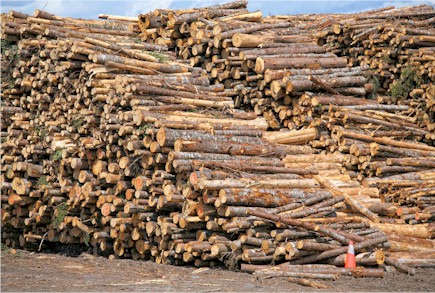 In the event of a nuclear accident in which radionuclides are released into the biosphere, radioactive contamination of forests can become a significant potential source of public radiation exposure. Cesium 137 and strontium 90 remain in the upper soil layers in forest ecosystems for a long time. These radionuclides get into the wood via the roots and can thus store radioactivity and represent a potential radiation exposure for humans. We provide an overview of our radioactive measurements as well as a literature review on wood, pellets and ash with a focus on cesium 137
In the event of a nuclear accident in which radionuclides are released into the biosphere, radioactive contamination of forests can become a significant potential source of public radiation exposure. Cesium 137 and strontium 90 remain in the upper soil layers in forest ecosystems for a long time. These radionuclides get into the wood via the roots and can thus store radioactivity and represent a potential radiation exposure for humans. We provide an overview of our radioactive measurements as well as a literature review on wood, pellets and ash with a focus on cesium 137
Two of these accidents – the Kyshtim accident in the Urals in the USSR (now the Russian Federation) in 1957 and the Chernobyl accident in the USSR (now Ukraine) in 1986 – resulted in significant contamination of thousands of square kilometers of forest land with radionuclide mixtures, including long-lived fission products such as Cs 137 and Sr 90. Measurements and modeling of forest ecosystems after both accidents have shown that after initial contamination, the activity concentration of long-lived radionuclides in wood gradually increases over one to two decades and slowly decreases over the following decades Period. The longevity of contamination is due to the slow migration and persistent bioavailability of radionuclides in the forest soil profile, leading to long-term transfer into wood through the tree root system.
The transfer of cesium-137 from the soil into the wood of trees is relatively low. Wood from Germany is radiobiological harmless to humans. In the ashes, however, the radiocesium activity can be up to 100 times higher than in wood.
Studies of Cs-137 and K-40 in wood from trees.
The following investigations are excerpts from the final report “Radioactivity in Wildlife”, where the radioactivity was also determined by gamma spectrometry from wood, roots, leaves and bark of trees on permanent sample plots (Fielitz 2004). All activity data refer to dry matter!
Aims and methods
Trees play an important role in the elemental balance of forest ecosystems. Therefore, the distribution of radiocesium and potassium-40 in different tree species was investigated on the sample plots. The trees were divided into the following compartments: Leaf organs, branches, bark, wood, roots < 5 mm and roots > 5 mm.
The objective of this study was to determine the extent to which the various tree tissues accumulate radiocesium and the differences in metabolic-physiological behavior between Cs-137 and K-40. Ultimately, this was also intended to answer the question of whether radiocesium is suitable as a tracer for potassium in forest ecosystem research.
Sampling was mainly done in 1992 on permanent sampling plots B1 (Bavaria) and F1 (Lower Saxony). Only a few compartments of some tree species could be examined, and even these only in small numbers. In these cases the statistical evaluation of the measurement results was omitted. Most of the samples could be analyzed for B1 of spruce and for F1 of pine. Transfer factors for Cs-137 were calculated for the individual tree compartments. Since tree species differ in the formation of their horizontal and vertical root systems and thus take up nutrients from different soil depths, the transfer factors were calculated on an area basis. No transfer factors were calculated for branches and bark, because part of the activity present in these compartments still originated from dry and wet deposition from the Chernobyl fallout. For some compartments, the fractions of Cs-137 activity originating from nuclear weapon and Chernobyl fallout were additionally calculated to better understand translocalization processes and long-term behavior of Cs+ ions in tree organs.
Distribution of cesium 137 and potassium 40 in needles, bark, wood, roots and leaves
The results are given in table 1. For the activity data of spruce needles, only the measurement results from the 1st and 3rd needle year were considered, because the individual needle years differed from each other in their biomass and Cs-137 content (younger needles have a lower biomass than older ones). This selection was also made with respect to the stock calculation in order to estimate Cs-137 and K-40 stocks in needle mass as realistically as possible.
The compartments of each tree species differed in their specific Cs-137 and K-40 activities. Both nuclides showed different distribution patterns. Between trees of the same species, Cs-137 activities in the same compartments varied by up to an order of magnitude.
Measured values of radioactivity of beech, birch, spruce and rowan trees
The K-40 measurement data of the individual compartments were partly normally, partly log-normally distributed. For example, the arithmetic mean of specific K-40 activity in bark of spruce (Picea abies) on B1 was 36 Bq/kg, the median 38 Bq/kg, with a minimum value of 14 Bq/kg and a maximum value of 61 Bq/kg. In contrast, the arithmetic mean of needles from these trees was 200 Bq/kg, the median was only 130 Bq/kg, while the measured values ranged from 63 – 620 Bq/kg. B1 ansd B2 are permanent sample plots in Bavaria.
